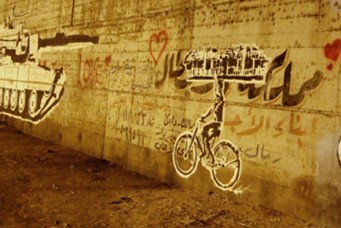The Graffiti Speaks Eloquently
The most fascinating thing I saw in Cairo was the range of graffiti scrawled across walls, advertising billboards, street signs, flower pots, park benches and any other surface that allowed Egyptians to express their political sentiments.
It has been illuminating this week to spend time in Cairo during the constitutional referendum and the run-up to the January 25 anniversary of the massive demonstrations that eventually toppled the Husni Mubarak regime in Egypt three years ago. The ever-changing dynamics in Egypt and across the Arab world paint a volatile picture of a region lurching forwards and backwards in its people’s determined drive to shape their own political cultures, after over half a century of police state-like governance systems.
Egypt will have a huge impact on developments across the Arab world in the years ahead, but how Egypt develops itself will not be clear for a few more years. It is simplistic and childish to note, as many have in the region and abroad, that the Arab “Spring” has turned into a forlorn Autumn or even a dark Winter. Such hasty and absolutist verdicts reflect deep amateurism, infant-like ignorance, and perhaps even some cultural-nationalist hostility towards Arabs, in not acknowledging the time-consuming normal trajectory of the kinds of historic, complex transformations that we are experiencing around the region. Making the transitions from primitive governance or police state systems to pluralistic democracies that safeguard the equal rights of all citizens requires decades at best, and a century and a half in most cases (as in the American and Western European cases).
So three years is a very short period of time in the very initial phases of our Arab transformations, and it is absolutely normal to witness the wild swings in developments that we experience across our region, including episodic violence alongside intense constitution-writing.
I spent quite a bit of time driving all around Cairo to speak with Egyptians and resident foreign observers from different walks of life, but mostly to get a feel for the rhythms of street life and the public arena that ultimately will shape the course of Egypt’s future. Experiencing my first-ever faint whiff of teargas as we drove near Cairo University while demonstrations were taking place was most noteworthy mainly for showing how life continued apace for millions of Egyptians who simply detoured a few blocks around the university district. Two students were killed in the demonstrations that day, and it is likely that many more men and women across the region will lose their lives in the continuing struggles for freedom, dignity, democracy and whatever other desired objectives ordinary Arab men and women seek as they continue exiting from the dark chamber of their frozen history of the past half century or so.
The most fascinating thing I saw in Cairo was the range of graffiti scrawled across walls, advertising billboards, street signs, flower pots, park benches and any other surface that allowed Egyptians to express their political sentiments. This captured for me the two most important historical developments that we can identify at the end of the third year of the ongoing Arab uprisings and transformations: first, the birth of Arab citizens who feel they have socio-economic and political rights and are prepared to speak out, mobilize and take action to achieve those rights; and, second, the birth of a public political sphere in which citizens can express themselves and compete peacefully for the exercise of power.
Citizens writing graffiti capture those two developments quite nicely, and the content of the graffiti is equally telling. The formal public space of Cairo (billboards, advertisement panels, newspapers and magazine covers on the sidewalks) was dominated by admonitions to vote ‘yes’ in the referendum and support the interim government installed by General Abdul Fattah Sisi and his military colleagues. The walls and other informal spaces reflected many more varied views, including the very common statement “yasqut kul min khan, ‘askar, fulul, ikhwan” (“down with all those who betrayed us; the military, the old guard, and the Muslim Brothers”). Other graffiti called Sisi a killer, or warned that another revolution was imminent.
The military-appointed government tried in places to paint over the graffiti but gave up after every wall it painted white was full of graffiti again 24 hours later. So the new public political sphere that continues to experience its birth across Egypt lurches back and forth between popular sentiments that support and oppose all three principal actors who have dominated the public power structure in the past few years—the old guard of the Mubarak era, the military, and the Muslim Brotherhood.
The new element today that Egypt still displays is that those who control the power structure—now it is the second military republic in three years—do not totally control the public sphere, or the minds of all Egyptians. That is a meaningful milestone on this third year of the Egyptian and other Arab uprisings that cannot be denominated in seasons of the year, but rather only in the attitudes of individual citizens who are determined to express themselves politically and in public.
Rami G. Khouri is Editor-at-large of The Daily Star, and Director of the Issam Fares Institute for Public Policy and International Affairs at the American University of Beirut, in Beirut, Lebanon. You can follow him @ramikhouri.
Copyright © 2014 Rami G. Khouri—distributed by Agence Global


